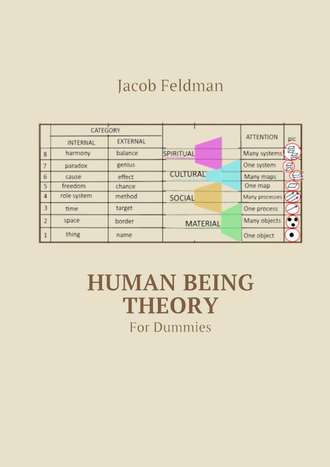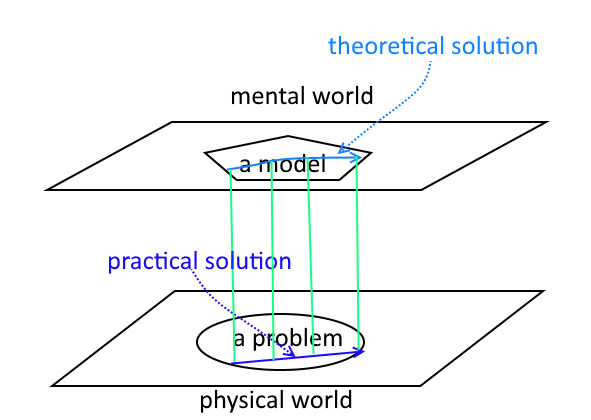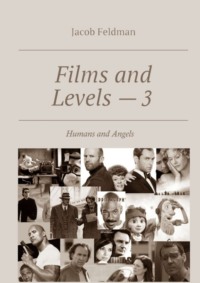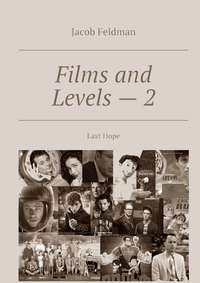
Полная версия
Human Being Theory. For Dummies

Human Being Theory
For Dummies
Jacob Feldman
The time is out of joint. O cursèd spite,
That ever I was born to set it right!
William Shakespeare, Hamlet© Jacob Feldman, 2017
© Яков Адольфович Фельдман, cover design, 2017
ISBN 978-5-4483-4271-4
Created with intellectual publishing system Ridero
1.Prologue
Preface
I have a son. He is 26 years old now.
When I send him a message about very IMHO important reading, his usual answer is: TLTR – too long to read.
Therefore, first, if I want to be readable for young generation I must be brief.
Second, we all live in the world full of vacuum cleaners and dishwashers.
Therefore, good book must be as clear as an instruction for dishwasher (or vacuum cleaner, if you please).
Third, it must be new. Not as new as a newborn child, because a very new child is born on the planet every second, but as new as a good effective drug for illness
not curable before.
Fourth, it must be useful for everybody who is smart enough, useful for everyday life, like a teaspoon. Are you smart enough for a teaspoon to use?
So, let us begin.
[битая ссылка] Some of pictures in the book are omitted – but you can find them here>> to pictures
Questions we will find answers for
How to be happy?
How to keep dialog?
How to choose the spouse?
How to keep marriage happy?
How to find the job of your dream? In addition, how to get it?
How to hire good team for the project?
How to understand, what politicians say, and what do they really mean?
How to nurture your own children?
What is a good education?
Does human history have a direction? And, if yes,
Where this direction is pointing?
Does it give us any reason to be an optimist?
How this historical movement could be measured?
How can we help the movement?
What is philosophy?
Do we need philosophy in the modern world? For what purpose?
How philosophy should look today?
What is the difference between science, religion and myth?
How our thinking works?
What is good and evil?
Could we understand what happens in modern world? And, if yes,
How could we?
Practical recommendations
Usually, whenever I lecture this stuff, I draw on the flipchart and explain the drawing step by step. Then I record video and load it on Internet. You can find my video-lectures (most in Russian) at [битая ссылка] my channel. After that I write it down as a text, make pictures and load as html-pages [битая ссылка] on my site. Pictures at the site show drawings step by step. However, in the book I place only final drawing. That’s why I strongly recommend you, whatever chapter you read, find the final drawing, copy it by pencil at your copy-book, and, while reading the text, mark over step by step new details by pen. Otherwise, I suppose it will be hard for you to understand my message completely.
Disclaimer
Is it possible at all – to answer so many hard questions in so thin book like that? Is it a fraud of some kind? No, it is not.
First, the answers we will see are not the only possible ones. You can find other versions from other authors.
Second, to make some answer working in your personal case, probably additional investigation may be needed. This investigation could be hard to do. So, probably, the life is not so easy as it means to be.
Third, you can find some parameters I have missed. Anyway, let us be friends and cooperate on the subject for common good.
2.Minor models
We need instruments
One apple up on top!
Two apples up on top!
Look, you,
I can do it too.
Look! See! I can do three!
But I can do more!
You have three!
But I have four!
Ten Apples Up on Topby Dr.SeussImagine you have a table.
Imagine you have on your table an old watch. Like this one.
Fig. 1. Old Watch
Imagine this watch is working badly, and you know how to fix it.
But if so, you need some special instruments to do it up.
Glasses, screwdriver, tweezers, toolbox, … like that.
Fig.2. Glasses
Fig.3. Screwdriver
Fig.4. Tweezers
Fig.5. Toolbox
Now. Imagine you have on your table the world of human beings, like that.
Fig.6. The Globe
It works badly and you know how to fix it.
But what instruments do you need for that?
I recommend you four mental instruments to begin with.
Recognize-and-name-it operation (RNO) = glasses.
Distinguish-and-separate-it operation (DSO) = screwdriver.
Enumerate-and-sort-it operation (ENS) = tweezers.
Put-in-lines operation (PLO) = toolbox.
From now, I will say:
«apply ONE» instead of «recognize and name it»,
«apply TWO» instead of «distinguish and separate it»,
«apply THREE» instead of «enumerate and sort it»,
«apply FOUR» instead of «put it in lines».
First look at the problems
Imagine ALL the problems of ALL human beings.
Now apply ONE and recognize in the middle a Self Area.
When you are in the area, you feel comfortable or not, happy or not, but you have no logics, no rules, nothing.
In this area, you are The Self.
Now apply TWO: see, out of the area there is outer world that presses on you, torture you, and restrain you.
But between Self And Outer world there is a narrow ring of compromise.

Fig.7. Self against World
Now we will analyze the ring.
Apply ONE: problems without parameters of specific person are controlled by philosophy.
Apply ONE again: problems with parameters of specific person are controlled by psychology.
These two areas are poles of the ring.
I like to place philosophy at the top (at North Pole) and psychology at the bottom (at South Pole). If so, we have two gaps between North and South: one on the West and one on the East.
It is clear that when we go from psychology to philosophy, we have to eliminate personal data from the problem. We have two options how to do it.
We can eliminate personal data immediately and go through history and sociology.
Or we can hold them as long as possible and, in this case, go through child development and educational systems.
THREE and FOUR operations were applied there.
And here is the result.

Fig.8. West path and East path.
Second look at the problems
Look! See, now
I can hop
with four apples
up on top.
And I can hop
up on a tree
with four apples
up on me.
Ten Apples Up on Topby Dr.SeussIn fact, philosophy is in charge of all these different things. And I mean to say something new about all of them.
Look at the table. There are three columns in it. Left columns faces at science and deals with knowledge of different kinds. Right column faces at art and deals with values. The column in the middle deals with worldviews.
Left column contains epistemology, methodology, logics, and law. Right column contains axiology, ethics, aesthetics, and moral. The column in the middle contains ontology, myth, religion, and ideology.

Fig.9. Knowledge, worldview, values
When moving from bottom up you see that position of neutral observer is gradually transformed into position of active actor who less and less looks around, but more and more presses on things to make them fit the pattern.
Philosophy is supposed to be neutral, so we put it at the South. Now, view from the South is philosophical.
But how can we name the view from the North? I failed to find good name in the language and invented a new one: regulatorics. This is a view of someone who wants to transform the world.
Add the 12 areas in this chapter to the 7 areas from the previous one and get complete syllabus of the Human Being Theory.
Why philosophy still in the game?
Look here, you two!
See here, you two!
I can get five on top
Can you?
Ten Apples Up on Topby Dr.SeussA long, long time ago, when I was a little bit younger, a simple question came in my mind.
Why philosophy still in game?
Why people pay for these boring books, why they reprint them?
I could understand people who pay to listen to violin or to watch olimpic games.
But philosophy?
Today I see philosophy as a poor answer for a real question. It looks like unsavory food you eat because you are hungry. But what is a question?
Ignore what philosophers say about the main question, don’t believe them. The real question must exist before and out of any philosophy.
Communication

Fig.10. Message
Imagine two people in dialog.
Person A sends to person B a message C about object D.
You can focus on object. This approach produces science.

Fig.11. Focus on object
You can focus on message as a tool to express your opinion etc.. This approach produces art.

Fig.12. Focus on message, its expressive possibilities
But imagine a dialog where participants do not understand each other. They want but they cannot for some reason. Probably they have different contexts in their heads. You can focus on these contexts. This approach produces philosophy.

Fig 13. Contexts differ.
Between science and philosophy
I am so good
I will not stop. Five!
Now six!
Now seven on top!
Ten Apples Up on Topby Dr.SeussSuppose you have found some very new idea and you want to tel it to your colleague. But the idea is so radically new that you partner does not understand you. What should you do?
Probably you should pack your idea into right form? This way leads to logics. Probably you should tell your partner how did you get to this great idea. This way leads to methodology. Probably you should tell your friend where any new ideas come from. This way leads to epistemology. Probably you should tell your friend how this world works. This way leads to ontology.
But for really new idea all this does not help.
Unexpected result: next generation of readers will consider you as a serious philosopher.
Fig.14. Philosophers
When we have a model
Seven apples
up on top!
I am so good
they will not drop!
Ten Apples Up on Topby Dr.SeussSuppose you live your regular life.
Suppose in some moment of your precious life you feel, that something goes wrong.
You feel it must be fixed. But how?
This moment of your life, this point of the space-and-time-and-person, this point and its neighborhood, I call them a problem. The problem is a part of physical world.

Fig.15. Physical world

Fig.16. Knowledge
Suppose we could describe the problem in some detailed and consistent way. I call this description a model.
The model exists in a mental world. There is a good detailed mapping between problem and model. This triplet of «problem, model, and mapping» I call it knowledge. Is it a true knowledge? Or is it a false knowledge? We do not know yet. Anyway, we try to solve our problem using the model.

Fig.17. Practical solution
First, we investigate the model and find some theoretical solution.
Second, we map this solution into the physical world and get the practical solution. Practical solution tells us what to do.
So, third, we do it, we implement the practical solution.
And fourth, we look around an decide is the problem solved now or it is not yet.
Suppose we many times came to the (almost) same problem and always solved it with the same model successfully. If so, we can say that this knowledge is true. If sometimes it works but sometimes it does not, we call it false knowledge.
When we have no model
«Where do you come from?»
said the Red Queen.
«And where are you going?
Look up, speak nicely, and don’t twiddle your fingers all the time!»
Through the Looking Glassby Lewis CarrollOne step back.
Suppose we have a problem but the life is not easy now and we cannot find a good model. What should we do?
As in the swampy bog, we jump from one dry place to another. Sometimes we have a choice and time to think and choose where to jump, left or, may be, right.

Fig.18. Values
When we think some images came to our mind, one image for the left turn, another image for the right turn. We can compare these images, choose the best one and make the jump toward the better future. If so, the images we compare, I call them values.
How many worlds do you know?
Five, six seven!
Fun, fun, fun!
Seven, six, five, four, three, two. one!
Ten Apples Up on Topby Dr.SeussWhat do we know about mental world?
First, there is an eternal part of the mental world, like PI number. I call it mathematical reality. We do not build mathematical objects – we discover them like stars in the sky.
Second, there are pure mental objects, which we build. They live while we support them. Words of languages, heroes of legends, music and dance. I call it virtual reality.

Fig.19. Thinking: Worlds
And third, there are objects of physical reality that help as to control both virtual and mathematical reality. I call them symbolic reality.
By definition, physical object is a symbolic object if it points to something else for somebody who understand the pointing and this somebody exists now (or existed in the past).

Fig.20. Symbols refer to other things
By the way, physical reality consists of events, not objects. You can put word event instead of object in the last definition.
Why values are so stable
«I beg pardon, your Majesty,» he began,
«for bringing these in; but I hadn’t quite finished my tea when I was sent for»
Alice’s Adventures in Wonderlandby Lewis CarrolWhen our knowledge fails, we dismissed it.
When we lose after journey toward values, we keep them.
Only complete disaster could clean our head from broken ore obsolete values. Why it is so? Because when we lose after swamp journey, no specific value is responsible for the failure. One points toward another and everyone whispers «that’s him, not me». So nobody is guilty. And we keep them all.
Culture, brains and more
«I know what you’re thinking about.» said Tweedledum; «but it isn’t so, nohow»
Through the Looking Glassby Lewis CarrollSymbolic reality is not of human beings only. Animals, insects etc. use different kinds of symbols. But for now I will ignore any non-human life.
According the definition, neurons of our brains are symbolic objects too. So first part of symbolic reality is of brains.
Things out of our brains are human-made. If one person made the symbol and other person can read the symbol, it is culture.
And some symbols are made by person but no other person can read it. No name for this part.

Fig.21. Ideal world vs. Physical world
Pay attention, that mathematical and virtual reality together form ideal reality. Now we have ontology done.
Four kinds of pointers
Tweedledum and Tweedledee
Agreed to have a battle;
For Tweedledum said Tweedledee
Had spoiled his nice new rattle
Through the Looking Glassby Lewis CarrollThere are four kinds of pointers in the symbolic reality. I place them into culture but they exist in «brains» and «no name area» too.
First kind of symbols point to the one specific event in physical reality. I call it fact.
Second kind of symbols points to the class of similar events. I call it generalization.
Third kind of symbols point to the mathematical world, to one specific element of specific model. I call it concept.
Fourth kind of symbols point to the virtual world. I call it idea. Idea in turn can point to everything including facts, generalizations, concepts, idea and other symbol.
This is our understanding of
epistemology,
ontology,
axiology.

Fig.22. Facts, generalizations, concepts, meanings

Fig.23. Inside philosophy
Myth, Religion, Science
Just then flew down a monstrous crow,
As black as a tar-barrel
Which frightened both the heroes so,
They quite forgot their quarrel.
Through the Looking Glassby Lewis CarrollWhat is the difference between myth, religion and science? To answer this question I collected evidences.
1) Is there canonical texts?
2) Are there professionals?
3) What about authorship?
See answers in the table.

Fig.24. Canon, professionals, authorship
I suppose that these different features are outer manifestation of specific inner activity.
I suppose that the most valuable information in society circulates inside special hierarchies. There are three kinds of positions in such hierarchies: authors, translators, and consumers.

Fig.25. Authors, translators, and consumers
There are no professionals in the myth circulating.
There are no authors in religion (that’s why they need God as a Creator),
but there are authors in science.
It means that myth and religion (for some reason) do not use some parts of the hierarchy.

Fig.26. Myth, religion, science
Disclaimer. Pair «knowledge vs. faith» makes us to distinguish between consumers of science and consumers of religion. And this is bad idea.
Do not compare consumers of different kinds. They are very similar. Compare science, religion and myth as a systems.

Fig.27. Inside philosophy
3.Main model: levels of mind
Every model is a Heaven’s gift
«If it moves, salute it.
If it doesn’t move, pick it up.
If you can’t pick it up, paint it.»
US Military saying
Fig.28. Authors, translators, and consumers
Look at the picture and believe what I’m saying. There is one translator per one hundred consumers. There is one author per one hundred translators. There is one great idea per one hundred authors per generation. There is one author-made solid model per one hundred author-made great ideas. There are almost 10 000 000 000 human beings at the planet now. So we could expect 10 solid models being invented by one generation.
In this book, I present two solid models.
First model is called Levels-of-Mind Theory. It occupies 80% of the book. First version of the model was presented in Moscow in 1989, in Jerusalem and Toronto in 1994. But probably it was too early for humankind to understand that. The model went to attic to sleep. In 2005, one Moscow publisher (Alexey Trekhov, R.I.P.) helped me to make a book. In 2007, one smart reader of the book told me that my model has some common features with Spiral Dynamics (ask Google what it is).
Second model was called Personality Card. But because it contains description of Task Card and Rating, now I call it Big Triplet. I did it in 2011. It occupies last 20% of the book.
Aristotle was sure that Earth and Heavens couldn’t be described in the same language.
Galileo Galilei was not agree with him.
Isaac Newton made this unified language for Earth and Heavens.
Today many people believe that for every problem of human being we need specific language. I enumerated 7+12—1=18 areas pretending to have such specific language. Not taking in account pluralism inside of every area. But I believe that unified language for all human being problems could be created.
This creating is mission of my life.
Levels-of-Mind Theory
«But I don’t want to go among mad people,» Alice remarked.






